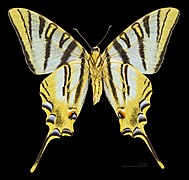Iberian sail butterfly
| Iberian sail butterfly | ||||||||||||
|---|---|---|---|---|---|---|---|---|---|---|---|---|

Iberian sail butterfly ( Iphiclides feisthamelii ) |
||||||||||||
| Systematics | ||||||||||||
|
||||||||||||
| Scientific name | ||||||||||||
| Iphiclides feisthamelii | ||||||||||||
| ( Duponchel , 1832) |
The Iberian Segelfalter ( Iphiclides feisthamelii ) is a butterfly from the family of the swallowtail butterfly (Papilionidae). For a long time it was not clear whether Iphiclides feisthamelii is just a subspecies of the sail butterfly ( Iphiclides podalirius ) or an independent species, but according to new findings it is a separate species, both genitally and genetically.
features
With a wingspan of 60 to 75 mm, the moths are among the largest butterflies in Europe. The wings with a pale yellow base color are traversed by black stripes, which partly merge into the hind wings. On the back inside of the hind wings there is a blue-black eye spot which is outlined in orange. On the edge of the hind wing are three sickle-shaped blue spots with a black border. Like all butterflies from the subfamily Papilioninae , this species also has black wing extensions.
The adult caterpillars have a green base color and are relatively thick in relation to their body length, becoming thinner and thinner towards the back. On the back there are reddish rows of dots and a light back line.
Similar species
There are three similar types, namely:
- Sail butterfly ( Iphiclides podalirius )
- Swallowtail ( Papilio machaon )
- Papilio alexanor
Of these species, however, only the swallowtail is represented in the range of the Iberian sail butterfly. However, this one has a slightly different pattern and a stronger basic color. The sailing butterfly also tends to have a stronger yellowish color, but the drawing elements are usually not as rich in contrast. A clear distinguishing feature is the orange bar above the blue-black eye spot of the hind wings, which is relatively wide and light in the sail butterfly, but quite narrow and dark in the Iberian sail butterfly.
Way of life
In the warmer areas, the species flies in at least four generations from March to October, in colder areas only 2 to 3 generations per year occur, and in the mountains, where the species occurs up to 2,500 msm, the species often forms only one generation per year Year off. The species overwinters as a pupa of the last generation.
Like other species of the family of the swallowtail butterfly (Papilionidae), the type operates hill-topping ( Engl. Hilltopping), fly here, mostly the males always a hill or a mountain dome down to a mate to find. The species only shows this behavior at low population densities. If the population density is high, the sexual partners also meet in other areas.
Caterpillar food
The caterpillars mainly feed on:
- Pears ( pyrus )
- Apples ( malus )
- Hawthorns ( Crataegus )
- White berries ( sorbus )
Occurrence and distribution
The Iberian sail butterfly occurs on the Iberian Peninsula as far as the Eastern Pyrenees and parts of North Africa . As a habitat, the species prefers warm and dry meadows, but also plantations and gardens. The species occurs up to an altitude of 2,500 m above sea level .
Web links
Individual evidence
- ↑ Aurélien Gaunet, Vlad Dincă, Leonardo Dapporto, Sergio Montagud, Raluca Vodă: Two consecutive Wolbachia -mediated mitochondrial introgressions obscure taxonomy in Palearctic swallowtail butterflies (Lepidoptera, Papilionidae) . In: Zoologica Scripta . tape 48 , no. 4 , July 2019, ISSN 0300-3256 , p. 507-519 , doi : 10.1111 / zsc.12355 .
- ↑ a b Lepiforum (section: Biology)




